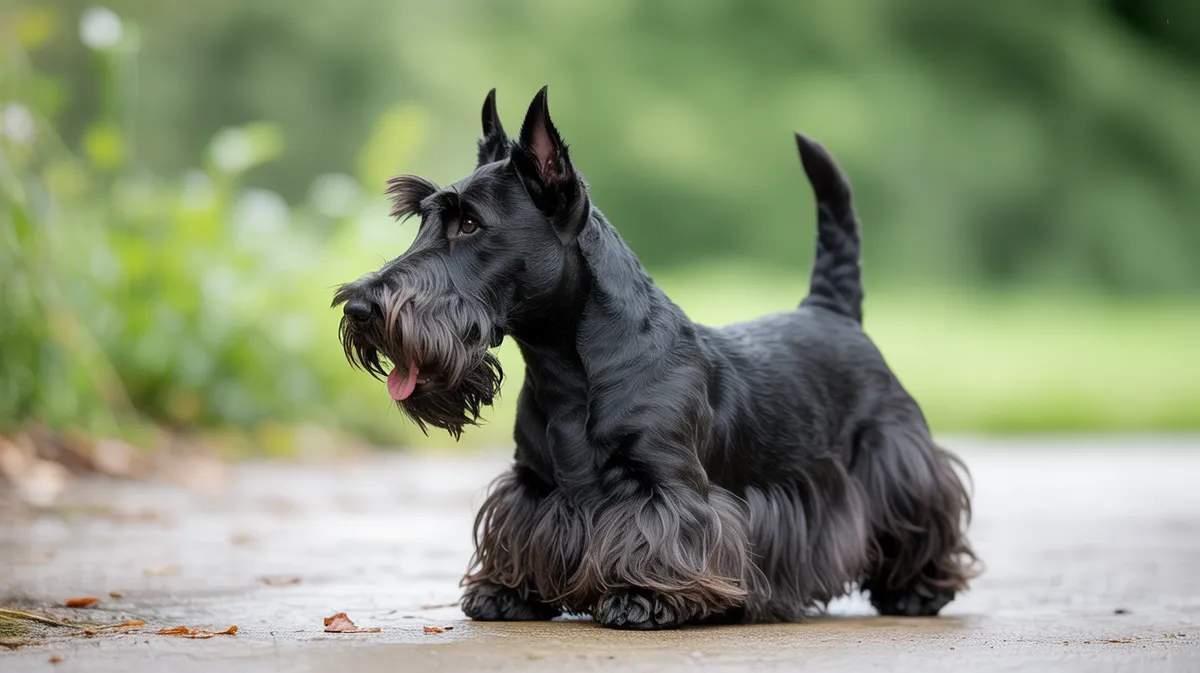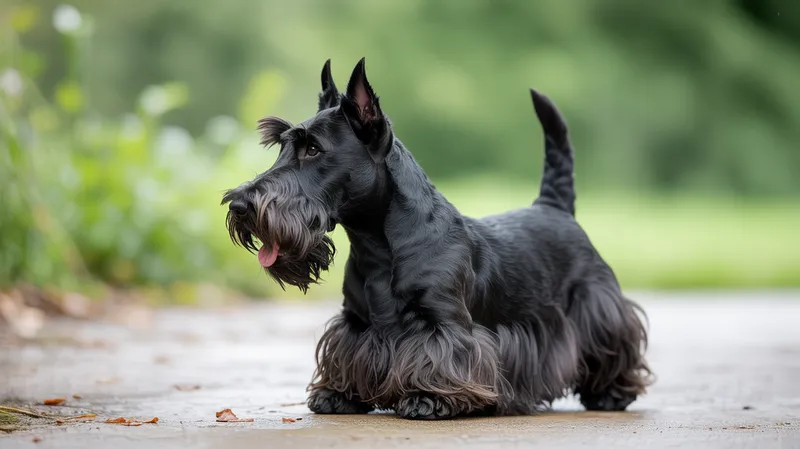
Scottish Terrier
Canis lupus familiaris

Meet the Scottish Terrier
The Scottish Terrier, affectionately known as the 'Scottie', is a small, sturdy terrier breed originally bred in Scotland for hunting foxes, rats, and other vermin. Characterized by its distinctive wiry black coat, pointed ears, and bushy eyebrows, the Scottie is both dignified and spirited. Despite its small stature, it is known for its confident and independent personality, often displaying remarkable loyalty to its family. Scottish Terriers are well-suited to both city and country living, making them popular companions worldwide.
Classification
Mammal
Habitat
Domestic environments
Diet
Omnivore
Lifespan
11-13 years
Conservation
Least Concern
Weight
8-10 kg
📖Fascinating Facts
Presidential Companions
Scottish Terriers have lived in the White House, most notably Fala, the beloved dog of President Franklin D. Roosevelt.
Bold Hunters
Originally bred to hunt foxes and badgers, Scotties are fearless and persistent despite their small size.
Distinctive Appearance
Their wiry coats, prominent eyebrows, and beards give the Scottish Terrier a dignified and recognizable look.
📋Detailed Description
The Scottish Terrier (Canis lupus familiaris), commonly known as the Scottie, is a compact, robustly built terrier breed distinguished by its short legs, deep chest, and pronounced head with a long, powerful muzzle. Adults typically stand around 25 cm (10 inches) at the withers and weigh between 8–10 kg (17.5–22 lbs) for males and 8–9.5 kg (17–21 lbs) for females. The breed is characterized by a double coat: a dense, soft undercoat and a hard, wiry outer coat, which provides excellent protection against harsh weather and rough terrain. Coat colors include black, brindle, and wheaten. Scotties have erect, pointed ears and expressive, bushy eyebrows, giving them a keen, alert expression. Their body is longer than it is tall, with a distinctive, level topline and a tail carried upright. Behaviorally, Scottish Terriers are known for their independence, intelligence, and dignified demeanor, often forming strong bonds with their families but remaining reserved with strangers. They exhibit a strong prey drive, a remnant of their origins as vermin hunters in the Scottish Highlands. The breed is generally healthy, with a lifespan of 12–15 years, though they can be prone to certain genetic conditions such as Scottie cramp and von Willebrand's disease. Their compact size and adaptable nature make them suitable for both urban and rural environments, though they require regular mental and physical stimulation. Scotties are not typically pack-oriented with other dogs but can coexist peacefully if socialized early. Their unique combination of physical resilience, intelligence, and loyalty has made them a favored companion and an enduring symbol of Scottish heritage.
💡 Did you know?
Scottish Terriers have a distinctive 'Scottie trot' — a brisk, jaunty gait unique to the breed.
🔬Research & Sources
Wikipedia Summary
The Scottish Terrier, popularly called the Scottie, is a breed of dog. Initially one of the highland breeds of terrier that were grouped under the name of Skye Terrier, it is one of five breeds of terrier that originated in Scotland, the other four being the modern Skye, Cairn, Dandie Dinmont, and West Highland White terriers. They are an independent and rugged breed with a wiry outer coat and a soft dense undercoat. The first Earl of Dumbarton nicknamed the breed "the diehard". According to legend, the Earl of Dumbarton gave this nickname because of the Scottish Terriers' bravery, and Scotties were also the inspiration for the name of his regiment, The Royal Scots, Dumbarton's Diehard. Scottish Terriers were originally bred to hunt vermin on farms.
Last Modified: 6/7/2025
🎭Behavior & Social Structure
Scottish Terriers are highly alert, self-reliant, and possess a strong territorial instinct, making them excellent watchdogs. They are known for their tenacity and persistence, traits that were historically selected for in their role as hunters of foxes, badgers, and rats. Scotties tend to be reserved or aloof with strangers but are deeply loyal and affectionate with their primary caregivers. They are generally solitary in their social structure, preferring the company of their human family over other dogs, although early socialization can mitigate inter-dog aggression. Scotties are intelligent and can be independent thinkers, sometimes displaying stubbornness during training; positive reinforcement and consistency are key. Their daily routines should include moderate exercise, such as brisk walks and play sessions, as well as mental stimulation to prevent boredom-related behaviors. When outdoors, their strong prey drive may lead them to chase small animals, so secure fencing is recommended. Indoors, they are typically calm and enjoy resting in a favorite spot, but they remain vigilant and responsive to environmental changes.
👶Reproduction & Life Cycle
Scottish Terriers reach sexual maturity between 8–12 months, though responsible breeding is typically delayed until at least 18 months of age to ensure physical and behavioral maturity. The breed does not have a specific breeding season and can mate year-round. The estrus cycle in females lasts approximately 2–3 weeks, with gestation averaging 63 days. Litter sizes typically range from 1 to 6 puppies, with 3–5 being most common. Parental care is primarily provided by the dam, who nurses and protects the puppies for the first 3–4 weeks. Puppies are weaned by 6–8 weeks and should remain with the mother and littermates until at least 8–10 weeks to ensure proper social development. Early socialization and exposure to various stimuli are critical for behavioral stability in adulthood. Breeders often screen for hereditary conditions such as craniomandibular osteopathy and von Willebrand's disease to maintain breed health.
🛡️Adaptations & Survival
The Scottish Terrier's most notable physical adaptation is its double coat, with a dense undercoat and a harsh, wiry outer layer, providing insulation and protection against the cold, wet climate of the Scottish Highlands. Their short, sturdy legs and compact body facilitate maneuvering through dense underbrush and narrow burrows while hunting vermin. The breed's strong jaws and pronounced muzzle are adapted for gripping and dispatching prey. Behaviorally, Scotties exhibit a high degree of independence and problem-solving ability, traits that were essential for working alone underground. Their acute sense of smell and keen hearing enhance their effectiveness as hunters. The breed's reserved nature with strangers and strong attachment to their family are thought to be adaptive for both guarding and companionship roles in domestic settings.
📚Research Sources
🎨Cultural Significance
The Scottish Terrier is an enduring symbol of Scottish heritage and has been featured prominently in art, literature, and popular culture. The breed's image is widely recognized, appearing as the black dog token in the board game Monopoly and as a mascot for various companies and organizations. Scotties have been owned by notable figures, including U.S. President Franklin D. Roosevelt, whose dog Fala became a national icon. The breed is associated with qualities such as bravery, loyalty, and resilience, reflected in the nickname 'Diehard' given by the Earl of Dumbarton. In Scotland, the Scottie is celebrated as a national treasure and frequently appears in parades and cultural events. The breed's distinctive silhouette and dignified demeanor have made it a popular subject in decorative arts and collectibles.
🔬Recent Research & Discoveries
Recent genetic studies have focused on identifying hereditary diseases prevalent in Scottish Terriers, particularly the genetic markers for craniomandibular osteopathy and transitional cell carcinoma. Advances in canine genomics have enabled breeders to screen for these conditions, improving breed health outcomes. Behavioral research has examined the Scottie's problem-solving abilities and independence, confirming their reputation as intelligent and sometimes stubborn companions. Ongoing studies are investigating the breed's predisposition to certain cancers, with the aim of developing targeted screening and prevention strategies. The Scottish Terrier is also included in broader research on the evolution and diversification of terrier breeds in the British Isles, providing insights into the impact of selective breeding on morphology and behavior.
🎥Wildlife Videos

Scottish Dogs: The Secret Life of Canine Nobility
Join us on a journey to uncover the fascinating world of Scottish dogs, where canine nobility reigns supreme. From the spirited ...
K9 SCOTTISH GERMAN SHEPHERD LIFE DOG INFLUENCER

Ben Fox Terrier In Scotland 2010 (HD)
Intrepid Ben sails forth to the land of mystery again, to discover new terrier haunts in Argyllshire, Scotland. Amongst his journey ...
Ben Foxterrier

Healey Nab & Back
Join Cassie & Pippa, our adventurous Affenpinschers ,as they climb up to the top of Healey Nab & take a walkies around the ...
AffieFilms

Dogs 101 - SCOTTISH TERRIER - Top Dog Facts About the SCOTTISH TERRIER
Dogs 101 - SCOTTISH TERRIER - Top Dog Facts About the SCOTTISH TERRIER Check out More at BrooklynsCorner.com The ...
Brooklyns Corner

Native Scottish Animals
Join us in our Page:http://www.facebook.com/ScotlandTravelDiscoverandknowledge Contact: ...
Ben Cherifa
🌍Habitat Information
The Scottish Terrier typically inhabits Domestic environments environments. Scottish Terriers have adapted to their environments with specialized features and behaviors.
Primary Habitat:
Domestic environments
More detailed habitat information will be available soon.
🛡️Conservation Status
The Scottish Terrier is currently classified as Least Concern. Conservation efforts are crucial for preserving this species for future generations.
Common Threats:
- 🏠Habitat loss and fragmentation
- 🌡️Climate change impacts
- 🎯Hunting and poaching
- 🏭Human-wildlife conflict
⚠️Threats & Conservation Challenges
As a domesticated breed, Scottish Terriers are not threatened in the wild, but they do face several challenges. Genetic bottlenecks from selective breeding have led to a higher incidence of inherited diseases, including Scottie cramp, craniomandibular osteopathy, and certain cancers (notably transitional cell carcinoma of the bladder). Responsible breeding practices and genetic testing are essential to mitigate these risks. The breed's popularity has fluctuated, with occasional surges leading to overbreeding and subsequent health issues. Urbanization and changes in lifestyle have reduced the demand for working terriers, shifting their primary role to that of companion animals. There are no significant conservation concerns for the breed, but maintaining genetic diversity and health remains a priority for breed organizations.
🔬Scientific Classification
Scientific Name
Canis lupus familiaris
Classification Hierarchy
🔍 About Taxonomic Classification
Taxonomic classification is a hierarchical system used by scientists to classify and organize living organisms based on shared characteristics and evolutionary relationships.
The system moves from broad categories (Kingdom) to increasingly specific ones, with each animal's scientific name typically consisting of its Genus and species.
📝Community Notes
Share your observations and insights about the Scottish Terrier with our community of wildlife enthusiasts.
Join Our Community
Sign in to share your observations and connect with fellow wildlife enthusiasts.
Sign In to ContributeNo community notes yet
Be the first to share your observations about the Scottish Terrier!
Explore Scottish Terrier
Select a tab above to learn more about this amazing animal.
📸Photo Gallery
No photos available for this animal yet.
🌟Discover More Wildlife
Continue your journey of discovery with more fascinating animals from our database
